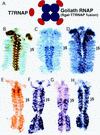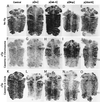Polycomb group repression reduces DNA accessibility
- PMID: 11533246
- PMCID: PMC99804
- DOI: 10.1128/MCB.21.19.6585-6597.2001
Polycomb group repression reduces DNA accessibility
Abstract
The Polycomb group proteins are responsible for long-term repression of a number of genes in Drosophila melanogaster, including the homeotic genes of the bithorax complex. The Polycomb protein is thought to alter the chromatin structure of its target genes, but there has been little direct evidence for this model. In this study, the chromatin structure of the bithorax complex was probed with three separate assays for DNA accessibility: (i) activation of polymerase II (Pol II) transcription by Gal4, (ii) transcription by the bacteriophage T7 RNA polymerase (T7RNAP), and (iii) FLP-mediated site-specific recombination. All three processes are restricted or blocked in Polycomb-repressed segments. In contrast, control test sites outside of the bithorax complex permitted Gal4, T7RNAP, and FLP activities throughout the embryo. Several P insertions in the bithorax complex were tested, providing evidence that the Polycomb-induced effect is widespread over target genes. This accessibility effect is similar to that seen for SIR silencing in Saccharomyces cerevisiae. In contrast to SIR silencing, however, episomes excised from Polycomb-repressed chromosomal sites do not show an altered superhelix density.
Figures








Similar articles
-
Probes of chromatin accessibility in the Drosophila bithorax complex respond differently to Polycomb-mediated repression.EMBO J. 1996 Feb 1;15(3):569-80. EMBO J. 1996. PMID: 8599940 Free PMC article.
-
The Drosophila Polycomb group gene pleiohomeotic encodes a DNA binding protein with homology to the transcription factor YY1.Mol Cell. 1998 Jun;1(7):1057-64. doi: 10.1016/s1097-2765(00)80106-9. Mol Cell. 1998. PMID: 9651589
-
The enhancer of polycomb gene of Drosophila encodes a chromatin protein conserved in yeast and mammals.Development. 1998 Oct;125(20):4055-66. doi: 10.1242/dev.125.20.4055. Development. 1998. PMID: 9735366
-
Cellular memory of transcriptional states by Polycomb-group proteins.Semin Cell Dev Biol. 1999 Apr;10(2):227-35. doi: 10.1006/scdb.1999.0304. Semin Cell Dev Biol. 1999. PMID: 10441076 Review.
-
Transcriptional silencing of homeotic genes in Drosophila.Bioessays. 1995 Sep;17(9):775-84. doi: 10.1002/bies.950170907. Bioessays. 1995. PMID: 8763830 Review.
Cited by
-
Isha is a su(Hw) mRNA-binding protein required for gypsy insulator function.G3 (Bethesda). 2022 Aug 25;12(9):jkac152. doi: 10.1093/g3journal/jkac152. G3 (Bethesda). 2022. PMID: 35708663 Free PMC article.
-
Inferring causal relationships among different histone modifications and gene expression.Genome Res. 2008 Aug;18(8):1314-24. doi: 10.1101/gr.073080.107. Epub 2008 Jun 18. Genome Res. 2008. PMID: 18562678 Free PMC article.
-
Towards T7 RNA polymerase (T7RNAP)-based expression system in yeast: challenges and opportunities.Bioengineered. 2022 Jul-Dec;13(7-12):14947-14959. doi: 10.1080/21655979.2023.2180579. Bioengineered. 2022. PMID: 37105766 Free PMC article. Review.
-
Differentiating Drosophila female germ cells initiate Polycomb silencing by regulating PRC2-interacting proteins.Elife. 2020 Aug 10;9:e56922. doi: 10.7554/eLife.56922. Elife. 2020. PMID: 32773039 Free PMC article.
-
Identification of genomic enhancers through spatial integration of single-cell transcriptomics and epigenomics.Mol Syst Biol. 2020 May;16(5):e9438. doi: 10.15252/msb.20209438. Mol Syst Biol. 2020. PMID: 32431014 Free PMC article.
References
-
- Ansari A, Cheng T-H, Gartenberg M R. Isolation of selected chromatin fragments from yeast by site-specific recombination in vivo. Methods Companion Methods Enzymol. 1999;17:104–111. - PubMed
-
- Bender W, Hudson A. P element homing to the Drosophila bithorax complex. Development. 2000;127:3981–3992. - PubMed
-
- Bienz M, Müller J. Transcriptional silencing of homeotic genes in Drosophila. BioEssays. 1995;17:775–783. - PubMed
Publication types
MeSH terms
Substances
LinkOut - more resources
Full Text Sources
Other Literature Sources
Molecular Biology Databases
